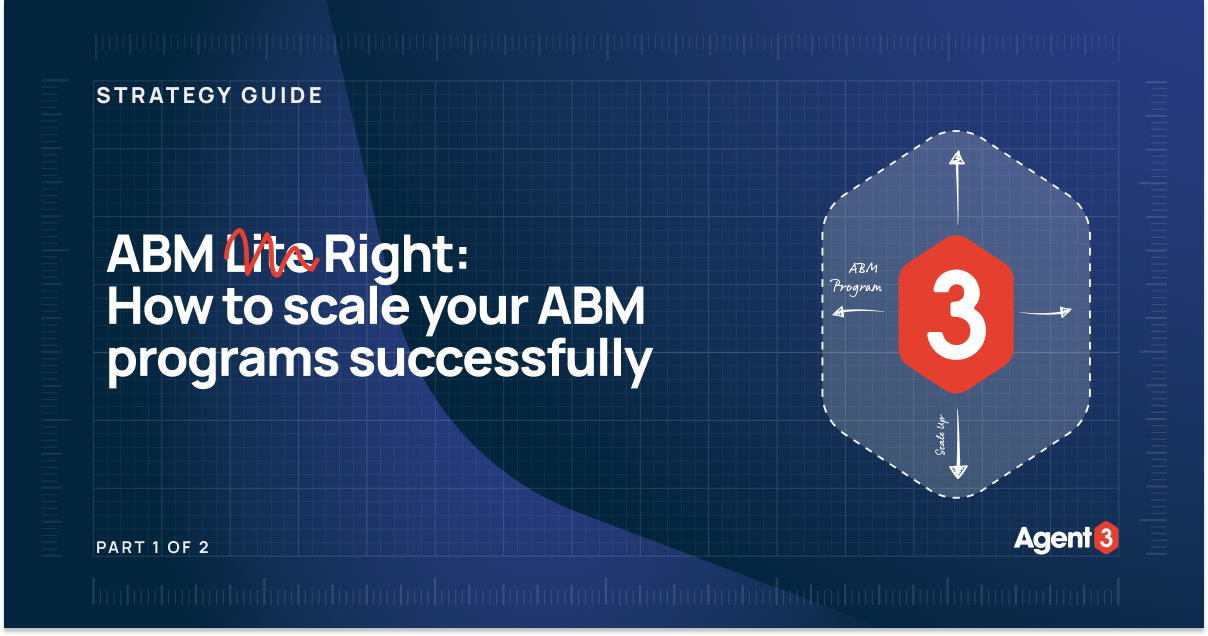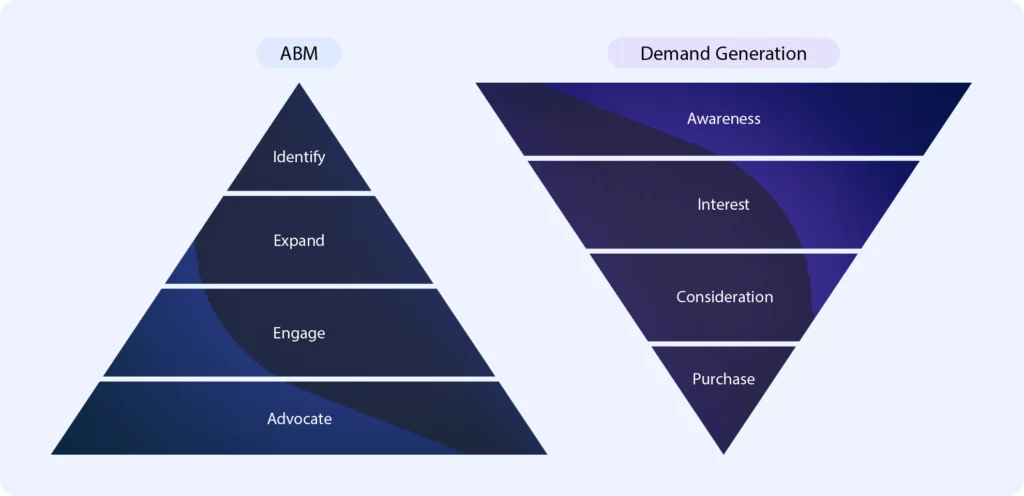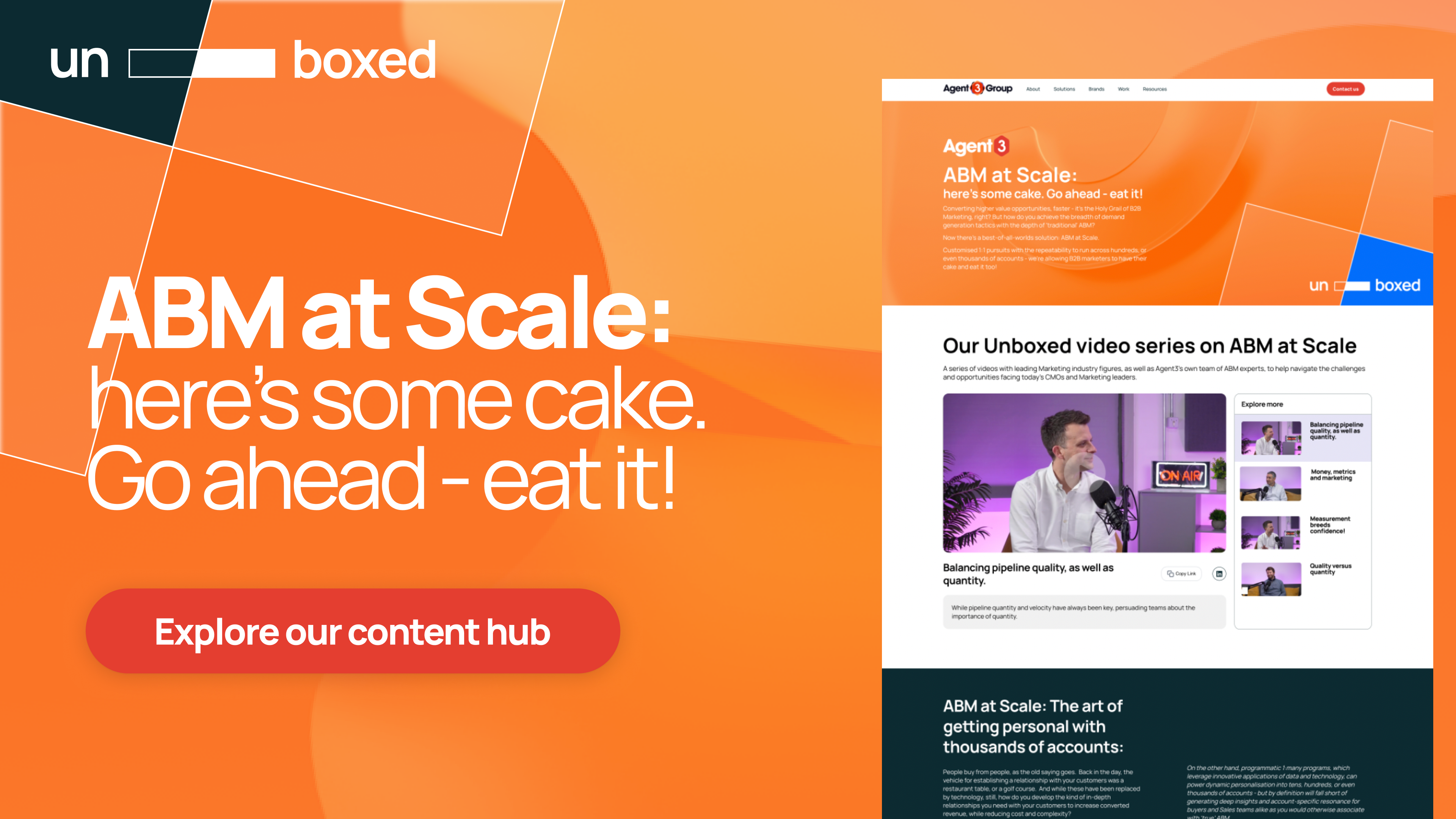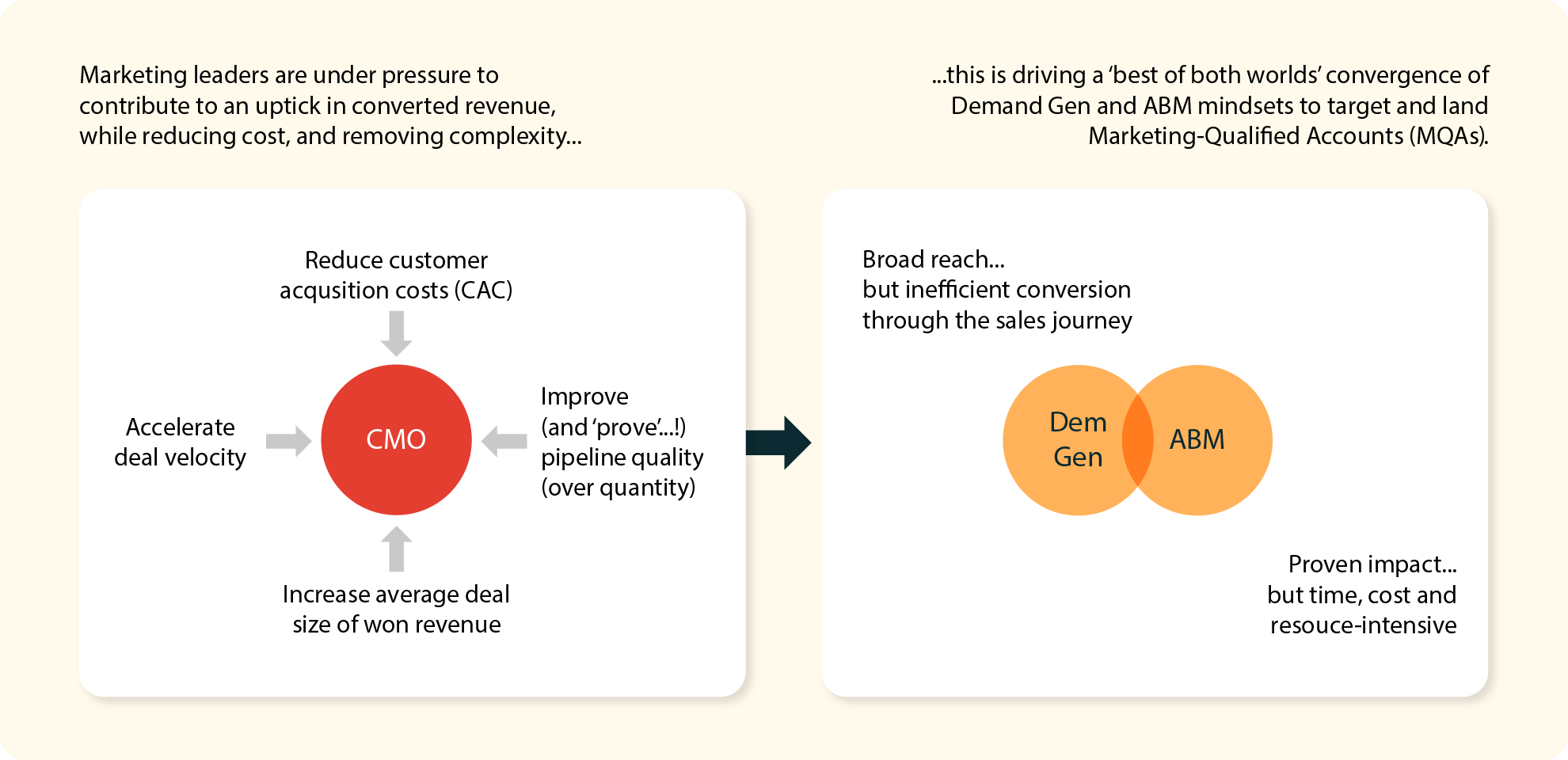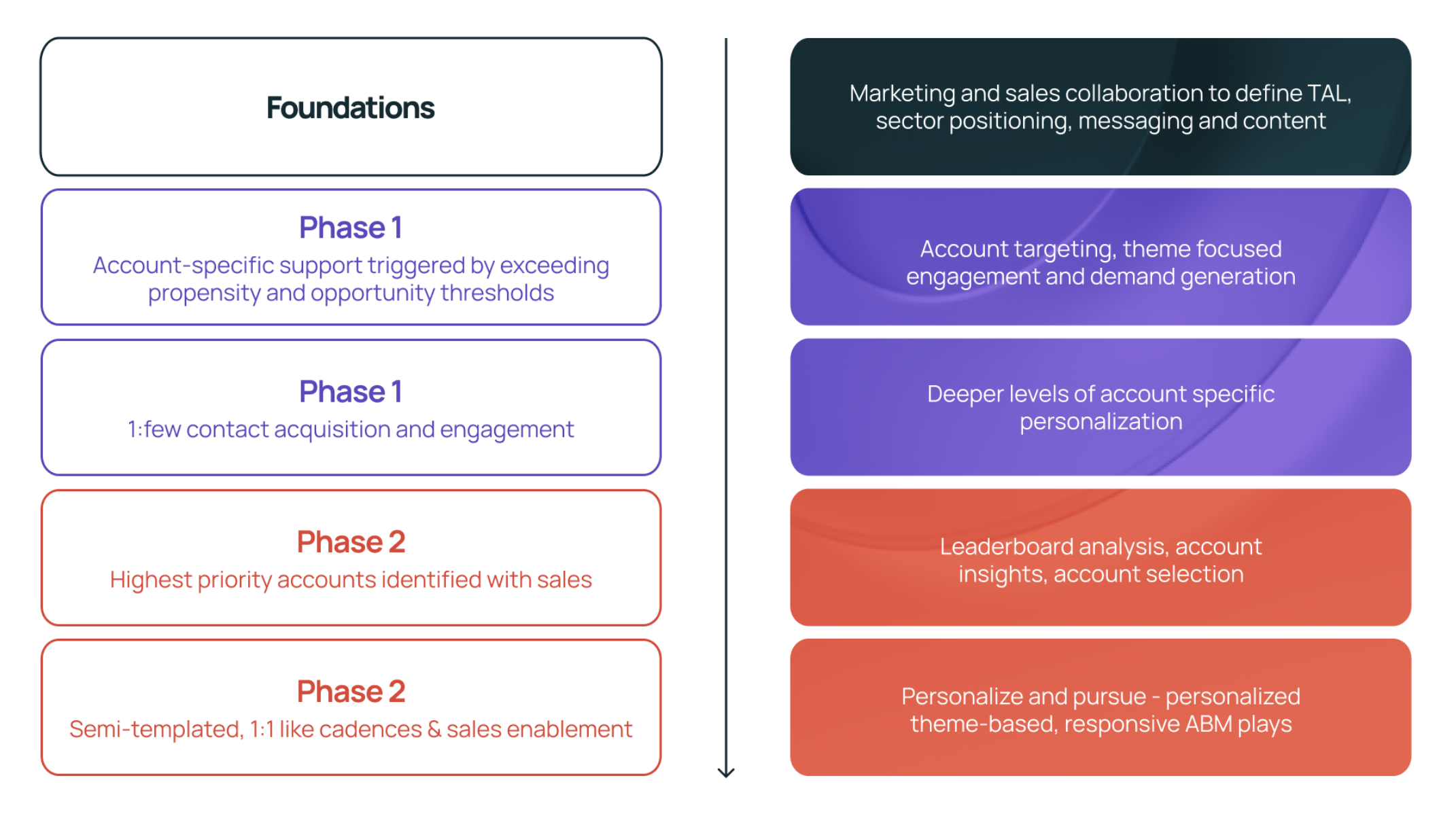The B2B marketing conversation has moved on: quicker conversions to closed revenue, larger average deal size, reduced customer acquisition costs and maximum customer lifetime value is the new talk of the town. And ABM at Scale can help deliver this. But it's a tough nut to crack. In this two-part series, we will guide you through your ABM at Scale program journey, sharing tips on scaling the proven impact of 1:1 and 1:few programs without over-indexing on resources and focus per account
1. What is ABM at Scale and why is now the time to act?
In today's rapidly evolving marketing landscape, the role of the CMO is undergoing a significant transformation. Traditionally focused on building brand awareness and lead nurturing strategy, today’s CMO is responsible for driving measurable, attributable commercial results, and so much more:
- Gaining a deeper understanding of customers, their markets and their macro-environments
- Building a differentiated brand that customers can identify with
- Defining the optimal customer journey using insight to be truly ‘outside in’
- Owning and leading the customer experience, including digital transformation efforts
- Aligning with sales to maximize the lifetime value of their most important customers
- Being an innovator and digital leader
- Working in harmony with sales to drive and deliver growth
It’s a far cry from bygone - and more subjective - days of brand building and ‘into the hopper’ lead generation. CMOs are now expected to evidence how they are driving higher-quality pipeline, accelerate conversion to closed revenue, lower the cost of acquisition, increase average deal size, and secure long-term customer renewals.
Standing out among all these metrics are two that have garnered outsized attention and importance: reducing ‘customer acquisition cost’ (CAC) - how much an organization spends on landing new customers - and maximizing ‘customer lifetime value’ (CLV) - total net profit a company can expect to generate from a customer throughout their entire relationship.
To succeed against these two metrics, CMOs need to consider a number of critical questions:
- Segmentation: Which markets, segments and accounts are the best fit, aligned to their ideal customer profile (ICP)
- High value pipeline: Which programs can they run to drive higher-quality pipeline with quicker conversion to closed revenue?
- Average deal size: What are they doing to increase average deal size?
- Renewal and retention: How can they help secure and expand customer renewals?
In other words, CMOs are now being held accountable for direct contributions to the bottom line. This shift in focus calls for a reevaluation of marketing strategies and a realignment of priorities. ABM programs go a long way toward answering these demands.
Yet in the rush to do more with less, the pressure to scale the initial impact of pilot and 1:1 ABM programs, the effectiveness, and consequently the results, can be diluted, or even lost. Traditional demand generation programs, however, while providing scale, do not provide the precision and results of ABM, so are often wasteful and lack focus.
ABM vs demand generation
Let’s look at the definition of 'true' ABM - treating each account as a market of one. And while scaling ABM holds the key to many prized metrics, we must think multiple moves ahead, thanks to greater scrutiny across the organization.
2. ABM until now
Account based marketing strategies have historically fallen into two camps, with the conventional wisdom being that each entails a degree of compromise.
- On the one hand, 1:1 and 1:few programs into finite handfuls of accounts have proven to drive impact. Yet they require a high degree of resource and focus per account - making them challenging to scale.
- On the other hand, programmatic 1:many programs, which leverage innovative applications of data and technology, can power dynamic personalization into tens, hundreds, or even thousands of accounts. These, by definition, will fall short of generating the deep insights and account-specific resonance for buyers and Sales teams that you would otherwise associate with ‘true’ ABM.
As ABM came to the fore across B2B organizations through the 2010s, many practitioners became almost tribal about their preferred approach. Dyed-in-the-wool 1:1 ABM-ers would decry 1:many ABM as ‘just good demand generation.’ Digital-first 1:many ABM-ers would chide small-scale ABM programs for being expensive and too inflexible to suit fast-changing organizational realities.
With CMOs under increasing pressure to deliver revenue, Agent3’s ABM at Scale solution helps shift how organizations evaluate their contribution. Instead of the tired, linear ‘waterfall’ mindset of baton-passing moments between the functions fixed on individuals (think Marketing Qualified Lead’ to Sales Accepted Opportunity, Sales Accepted Opportunity to Sales Qualified Opportunity, etc.), the focus here is on accumulating increasing opportunity intelligence across the buying committee, then leveraging this insight to tailor a more pertinent conversation between the vendor and the prospective buyer.
A typical demand waterfall
More on how this works in a moment.
3. Selecting the appropriate ABM strategy

Account Based Marketing strategies come in a variety of flavors and assessing which model is right for you depends on your company's goals, resources, target market, and stage of growth. Traditionally, there have been three main types of ABM:
- 1:1 ABM - Highly customized programs for individual accounts, treating each account as a market of one
- 1:Few ABM - A cluster of accounts that share common characteristics that can be engaged with a similar set of messages and activities, while maintaining an impactful level of account specific personalisation across the final ‘last mile’
- 1:Many ABM - Creating marketing campaigns for named accounts at scale, enabled by technology. Messaging and content often issues-based
To date, these models have worked well, but they don't provide the flexibility, scale and efficiency needed to meet the challenges of today’s CMO. At Agent3, however, we believe there is a way to address this, by bringing together the precision and exactness of 1:1 ABM, with the scale and breadth of demand generation.
We call this ABM at Scale.
The ABM at Scale solution from Agent3 offers the best of all worlds. It can help today’s CMOs deliver on key performance metrics and ROI goals. Including all-important CAC and CLV.
Breadth and depth across key account programs
4. Precision ABM versus ABM at Scale
At Agent3 we believe there are broadly two types of ABM: ‘Precision ABM’ that is true to the original roots of ABM, ie: treating an account as a market of one - or a few - and ‘ABM at Scale’ which blends the best of true ABM with the efficiency, scale and reach of demand generation tactics.
This hybrid approach leverages data-driven insights to identify clusters of similar accounts and applies customized messaging and outreach strategies to these groups, effectively marrying the best aspects of personalized ABM with the scalability required for broader market impact.
ABM model comparison table
5. Finding the right strategy for you
Deal size vs solution / product complexity
The best ABM strategy for your organization should align to your business’ go-to-market and will largely be determined by the products or solutions you’re selling, and crucially, your target audience (enterprise, mid-market or SMB). More complex solutions go hand-in-hand with larger deal sizes, and longer sales cycles. These factors point to a custom, 1:1 ABM approach. By contrast, a less complex solution and a smaller deal size requiring a less personalized approach would be better served by a scaled ABM program.
The diagrams below illustrates some of these factors:
Our ABM at Scale framework
In Agent3’s ABM at Scale model, the focus, resource and associated investment levels in any given account are aligned with something often overlooked in other ‘once-and-done’ account selection models: the impact over time of fluctuating propensity buying signals.
ABM at Scale framework - key principles
Our approach begins by targeting dynamically personalized, multi-channel digital campaigns across a segmented target account list (TAL), This creates a foundation to track interest and engagement signals across each account.
As the 1:many-style campaign is live, we track multiple 1st and 3rd party propensity signifiers to create a leaderboard. The leaderboard is pivotal to subsequent decision-making. It helps us determine which accounts within the TAL are ‘bubbling up’ to represent the most significant opportunity. The leaderboard also helps us garner insights, including:
- Which accounts engage most with the campaign?
- What messages, themes and pain points are they each responding best to?
- What pointers can we take from their contextual intent patterns?
- Which contacts are directly engaging with our Marketing and Sales channels?
- What have they told us about their challenges and priorities?
This campaign leaderboard is the conduit to drive an objective discussion between Marketing and Sales around the accounts that merit further ‘manual’ ABM support.
Working in tandem with BDRs, account executives, Sales Ops, and Sales leaders, we’ll shortlist specific accounts, then layer on more profound quantitative and qualitative research to understand more about each organization: decision-making. It helps us determine which accounts within the TAL are ‘bubbling up’ to represent the most significant opportunity. The leaderboard also helps us garner insights, including:
- How can we best appeal to nuances across their firmographic and technographic profile?
- How can we align our value proposition to specific aspects of their strategic roadmap?
- Which events and activities within the organization present a relevant ‘hook’ to drive a meaningful conversation?
- Who’s who across the buying committee, and why would they care about what we have to offer?
The creation and monitoring of an ABM ‘leaderboard’ provides a data-informed method for choosing the accounts deserving increased time, resources, and effort across Marketing, BDR, and Sales teams. You can then tailor your message and outreach activities, based on the accumulated insights gleaned, to ‘surround’ named target stakeholders on priority accounts.
By leveraging a turnkey set of engagement templates at this stage - account-specific content hubs, video explainers, value engineering reports, exec-to-exec direct mailers, etc. - we can mimic the sense of a truly custom 1:1 ABM pursuit, yet with a pragmatic sense of repeatability to run across multiple accounts in parallel.
In other words, best of all worlds. That’s ABM at Scale.
6. Organizational alignment
As we’ve shown, ABM at Scale has serious potential to support marketing objectives to reduce CAC, increase CLV and, ultimately, drive revenue growth and customer engagement. But to maximize results, the foundations must be in place in terms of organizational alignment.
Scaled ABM programs - more so than any other ABM model - require alignment across multiple departments within the organization:
- Marketing and Sales alignment: This is perhaps the most critical area of alignment for successful scaling of ABM programs. Marketing and sales teams - and leaders - need to work closely together to identify target accounts, create and monitor leaderboards, develop personalized messaging and content, and execute campaigns effectively. Close collaboration ensures that marketing efforts are aligned with sales objectives and sales enablement (eg:insights, profiles, sales engagement materials). In short, organizations which are committed to driving a more integrated role and relationship between sales and marketing to identify and progress any given opportunity, as opposed to those rooted in a binary 'hand-off' moment, will reap the benefits of ABM programs at scale.
- Marketing and Marketing team alignment: It is equally imperative that leadership across all Marketing functions (ABM / Field, Demand, Marketing Operations etc) work in tight collaboration, which may require breaking down typical silos. To succeed, teams need to agree tiered levels of focus and a data driven strategy and have clear definition of roles and responsibilities and SLAs around certain workflows and hand-offs.
- Data and Analytics alignment: ABM relies heavily on data to identify and prioritize target accounts, understand their needs and preferences, and measure the effectiveness of marketing efforts. The marketing, sales, and analytics teams need to work together to ensure that they have access to accurate and relevant data, and that they are using the right metrics to measure success.
- Technology alignment: If ABM at Scale is wholly reliant on the use of technology and tools for account identification, targeting, personalization, and measurement, it follows that marketing, sales and IT teams need to work together to select the right technology stack, integrate it with existing systems, and ensure that it meets the needs of the organization's ABM strategy.
- Organizational alignment: Successful ABM requires alignment not only within specific departments but also across the organization as a whole. Senior leadership needs to champion the ABM approach and ensure that all departments are aligned with its objectives. This may require changes to processes, incentives, and organizational structures to support ABM initiatives effectively.
7. Summary and what next?
In the first half of this guide, we’ve highlighted the increasing complexity of the marketing landscape and the associated evolution of the CMO’s role. With escalating pressure from an increasing number of metrics, ultimately, success will be measured on two key metrics: reducing CAC and increasing CLV.
ABM at Scale has the potential to drive mutual success around these measures by delivering:
- Increased propensity, by carefully selecting accounts that truly fit an organization’s Ideal Customer Profile (ICP)
- Being highly targeted, and thereby reducing waste
- Engaging target accounts and executives with data driven, highly crafted messaging and high value creative content
- Using dynamic and automated ways of engaging and shifting to a ‘responsive’ strategy white glove approach for those accounts with greater propensity and opportunity
- Marketing being in lockstep with sales from the outset and working to common goals
Increasing CLV will enable higher value conversations and ever deeper relationships with key customers. This in turn makes your marketing programs more productive, creating a greater probability of unearthing opportunities and renewals.
In conclusion, scaling ABM effectively requires organizations to re-think the purpose and dynamic of their Marketing, BDR, and Sales functions to become more collaborative around pursuing deals. By building a solid foundation of understanding, defining processes and workflows, integrating technology and data, fostering cross-functional alignment, and continuously optimizing and innovating, organizations can position themselves for success in scaling their ABM efforts and driving sustainable growth and revenue.
You can learn more about our ABM at Scale solution here.
Next: Read part 2 of this guide, where we explore in detail how to set up ABM at Scale for success.
